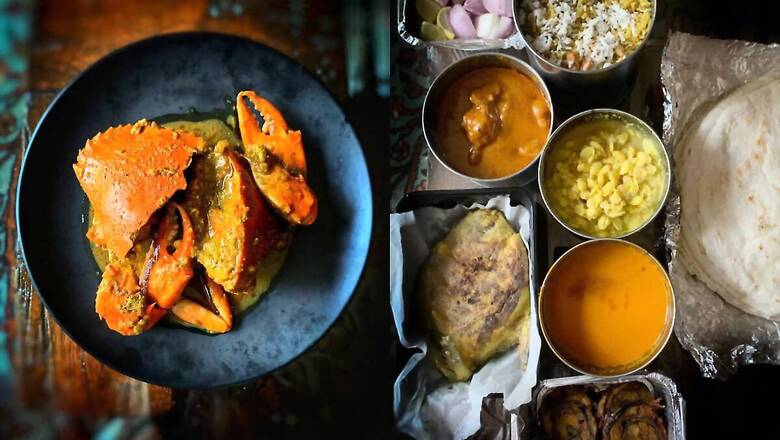
views
But amidst all this doom and gloom, a new warrior arose. The Home Chef. In its simplest form, the “daily dabba”. I was stuck at home all alone, with no help at all. And although I can cook, I just find the effort required to stock up and produce food three times a day just for myself a humdrum chore. So, after a couple of days of eggs and bread, I started exploring the neighbourhood. Just by chance, I spotted my building watchman eating his lunch. Curiously spying on his dabba, I saw that he had a bunch of chapatis, with a sabzi, rice and a thick daal. He looked like he was enjoying his dabba and I thought to myself that there is no reason, I couldn’t.
After enquiring with him, I called up the lady whose number he shared with me. I explained my dietary issues with her. That I need something non-vegetarian like chicken, prawns or egg in some form, every meal, I don’t like most vegetables, although I am partial to pulses like Chavli (black-eyed beans), Vaal (Lima beans), Moong, Matka, and I prefer chapatis to rice. We struck a bargain. She would send me a large meal every day, enough for lunch and dinner. With four large chapatis, sometimes a spicy masala chicken cooked in coconut gravy, or small shrimp tossed in sautéed onion with spices and soured with kokum. Black gram cooked in dark garam masala. Boiled eggs in coconut curry. Moong or matka in a sweet and spicy usal, made Maharashtrian-style. On some days, a simple yellow sukha aloo subzi with pooris. And this parade of simple home-cooked meals kept coming over the next few months at a measly Rs 90 per non-veg meal and Rs 60 for a veg meal. It was the first real home-chef moment for me.
Experiments in the Kitchen
While the traditional home chefs and dabba-makers thrived, some homemakers, bankers, advertising men, even fashion designers, all sitting at home in the lockdown, wielded ladle and pan and started taking refuge in their hobbies, their kitchen and their mother’s recipes. The end result was an explosion of traditional, regional Indian food, experiments, innovation and even new delivery services to bring that food to craving aficionados.
I was blessed to be made guinea pig by some of them. Friends, family and acquaintances started plying me with their productions, and I was tasting the most glorious food, nearly on a daily basis. One of the first people to send me food was adman-turned-chef Vivek Nayyar. He decided to just do a variety of mutton and chicken dishes and mastered the art of making really good homemade gosht. Bhuna Gosht and Smoked Matka Mutton, always with huge shanks filled with marrow. He also sent me a mean, creamy and luxurious Chicken Makhanwalla and a meaty, hearty haleem.
Straight from the Parsee kitchens of Navsari came Mahrukh Mogrelia of Mahrukh’s Kitchen. Rustic, robust and hardy Parsee food unlike the polished refined kitchens of Mumbai. Vatana ma Gosht (mutton cooked with green peas), Jardaloo Salli Marghi (chicken with fried potato straws and apricots), prawn kebabs, mutton cutlets, prawn curry rice and above all, Masala Fried Soondh, sweet, river-fresh blue green-shelled prawns all the way from her village.
Bimba Nayak, our friendly neighbourhood Pathare Prabhu chef who’s a veteran, created a special lockdown menu of Punjabi and Muslim food under her brand Cooking Concepts. Mutton Biryani with lots of mutton, smoky fried onions and soft potatoes. Potatoes which have imbibed all the flavours of the masala and ghee. Along with the Biryani came some Chicken 65 and Hyderabadi Dum ka Chicken which tasted so much like the Chicken Masala Fry from Olympia Cafe, but her hit number was her Pathare Prabhu-style Ghada. A sort of spicier Undhiyu with meat and fish. She also did a Pathare Prabhu special meal as did the author of India’s most comprehensive Pathare Prabhu cookbook, Kalpana Talpade. The Crab Khadkhadle, sent to me by Kalpana Talpade, took me back to my grandmother’s cooking.
Not Just Biryani, Butter Chicken
One fine morning, Amol Welling, of The Culinary Kitchen, sent me a vast menu which had Maharashtrian Brahmani food, Malvani food, a bit of agri-food and even Goan food. Unable to taste all the food in one go, I chose just a few dishes from his larger menu.
This is what I had for lunch that day. Masale Bhat, spicy rice with masala and vegetables, and made during festivals and weddings. This was delicately spiced, and wonderfully garnished with fresh coconut and peanuts. Along with this was Tomatoche Saar (a tangy and spicy thin tomato curry and usually eaten with rice). Dalimbi Usal (sprouted bitter field beans cooked with goda masala and coconut), Khamang Kakdi (cucumber salad with green chillies and peanuts), Malvani Mutton in a fiery red thick coconut curry with Bhakri and Bharlela Pomfret (a full, palm-sized pomfret, stuffed with green masala and fried). The pièce de résistance, however, was the Pathare Prabhu-style Alu Wadi (colocasia or taro leaves smeared with spiced, sweet and tangy gram flour, rolled, steamed and fried). Only these Alu Wadi, or what the Pathare Prabhus call Patwad, are stuffed with small shrimp, and trust me, it’s a lethal combination.
And this was not all. The food kept coming and is still coming. Next week, I shall introduce you to few more of these home-chefs who not only, in my opinion, kept the food and beverage world standing, but reminded us all that Indian food is not just Biryani and Butter Chicken.
Read all the Latest News, Breaking News and Coronavirus News here



















Comments
0 comment